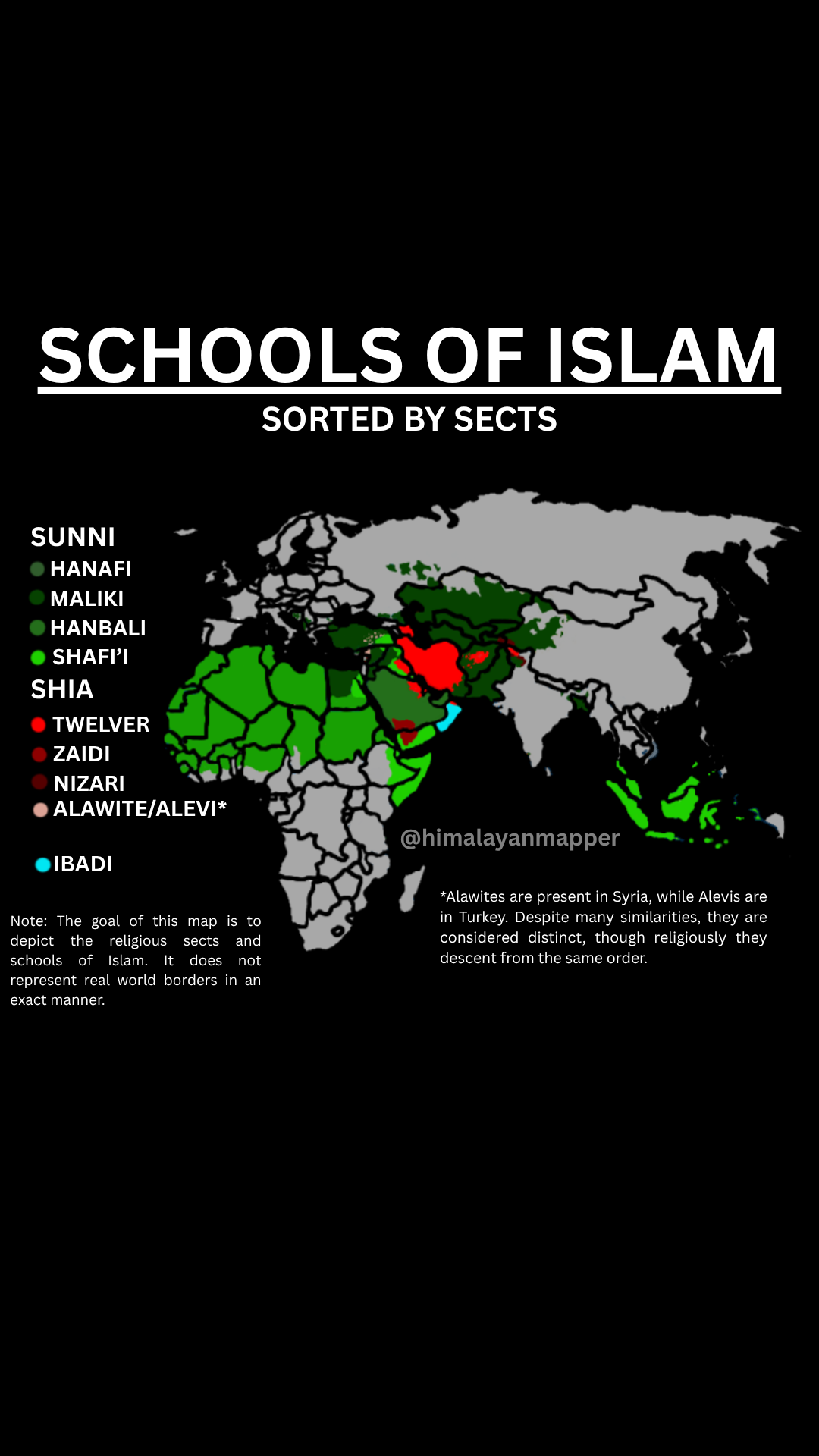Schools of Islam by Sects Map


Alex Cartwright
Senior Cartographer & GIS Specialist
Alex Cartwright is a renowned cartographer and geographic information systems specialist with over 15 years of experience in spatial analysis and data...
Geographic Analysis
What This Map Shows
The "Schools of Islam by Sects Map" provides a visual representation of the various sects within Islam, illustrating how these groups are distributed geographically across the globe. The map delineates the major sects, including Sunni and Shia, alongside smaller sects such as Ibadi, Ismaili, and others. By analyzing this map, one can gain a clearer understanding of how historical, cultural, and political factors influenced the development and spread of these sects, shaping the religious landscape we see today.
Deep Dive into Schools of Islam
Islam, the second-largest religion in the world, encompasses a rich tapestry of beliefs, practices, and traditions that are often categorized into different sects. The two largest branches are Sunni and Shia, which together constitute roughly 90% of all Muslims. The origins of these sects date back to a significant dispute over the rightful succession of leadership following the death of the Prophet Muhammad in 632 CE.
Sunni Muslims make up about 85-90% of the Muslim population. They believe in the elected leadership of the community and follow the teachings of the Quran and the Hadith (sayings of the Prophet) as interpreted through the four major Sunni schools of jurisprudence: Hanafi, Maliki, Shafi’i, and Hanbali. Each of these schools has unique interpretations and practices, influenced by the cultures in which they developed.
On the other hand, Shia Muslims represent about 10-15% of the Muslim world, primarily concentrated in Iran, Iraq, and parts of Lebanon and Bahrain. They believe that leadership should have remained within the Prophet's family, specifically with Ali, his cousin and son-in-law. This belief has led to the establishment of various Shia sects, including Twelvers, Ismailis, and Zaidis, each with distinct beliefs and practices. Interestingly, Twelver Shia Islam, the largest Shia sect, emphasizes the role of the twelve Imams as spiritual and political leaders.
In addition to these two major sects, there are smaller groups like the Ibadi sect, which is prevalent in Oman and represents a distinct interpretation of Islam that predates the Sunni-Shia split. The diverse beliefs within these smaller sects often reflect the historical and socio-political contexts of the regions in which they developed. For instance, the Ahmadiyya community, which originated in the late 19th century in British India, is considered non-Muslim by some traditional Islamic sects due to its belief in the continuation of prophetic revelations.
Understanding these sects is crucial because they shape not only religious practices but also political alliances and conflicts in various regions. For example, the Sunni-Shia divide has profound implications for geopolitics in the Middle East, influencing conflicts in countries like Syria and Iraq. Furthermore, the sectarian identities can drive social cohesion in some areas while fostering division in others.
Regional Analysis
The geographic distribution of these sects reveals fascinating patterns. For instance, the Middle East is predominantly Sunni, with significant Shia populations in Iran and Iraq. This division has historical roots, dating back to the early Islamic conquests and the subsequent political struggles that shaped the region's history.
In North Africa, Sunni Islam prevails, but there are pockets of Ibadi Muslims, particularly in Oman, where the unique practices and beliefs of this sect provide a contrast to the Sunni majority. Interestingly, countries like Tunisia and Algeria have also seen a rise in secularism, which impacts the practice and perception of Islam in these regions.
In South Asia, particularly in Pakistan and India, both Sunni and Shia communities coexist, although tensions have occasionally flared up, often influenced by political factors rather than purely religious ones. The Ahmadiyya community, which originated in India, has faced significant persecution, illustrating how sectarian differences can manifest in real-world implications.
In Southeast Asia, particularly Indonesia, the world's largest Muslim-majority country, Sunni Islam is dominant, but unique local traditions often blend with Islamic practices, creating a distinct cultural identity. This amalgamation of beliefs highlights how regional contexts can influence the practice of Islam, leading to a rich diversity within the sects themselves.
Significance and Impact
Understanding the divisions within Islam is vital for grasping current global dynamics, as these sects play essential roles in cultural identity, political movements, and inter-community relations. The ongoing Sunni-Shia tensions, for instance, have far-reaching effects not just in the Middle East but globally, influencing international relations, migration patterns, and even terrorist activities.
Moreover, the rise of sectarianism in some areas raises questions about tolerance and coexistence in increasingly multicultural societies. As globalization continues to connect diverse populations, the significance of these sects will likely evolve, with the potential for both conflict and collaboration.
In conclusion, the "Schools of Islam by Sects Map" serves as a critical tool for visualizing and understanding the complex interplay of religion, culture, and politics across the globe. By examining the geographical distribution of these sects, we can better appreciate the intricate tapestry of beliefs that shape the lives of millions of Muslims worldwide.
Visualization Details
- Published
- October 1, 2025
- Views
- 52
Comments
Loading comments...